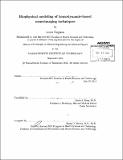Biophysical modeling of hemodynamic-based neuroimaging techniques
Author(s)
Gagnon, Louis, 1984-
DownloadFull printable version (15.74Mb)
Other Contributors
Harvard--MIT Program in Health Sciences and Technology.
Advisor
David A. Boas.
Terms of use
Metadata
Show full item recordAbstract
Two different hemodynamic-based neuroimaging techniques were studied in this work. Near-Infrared Spectroscopy (NIRS) is a promising technique to measure cerebral hemodynamics in a clinical setting due to its potential for continuous monitoring. However, the presence of strong systemic interference in the signal significantly limits our ability to recover the hemodynamic response without averaging tens of trials. Developing a new methodology to clean the NIRS signal from systemic interference and isolate the cortical signal would therefore significantly increase our ability to recover the hemodynamic response opening the door for clinical NIRS studies such as epilepsy. Toward this goal, a new method based on multi-distance measurements and state-space modeling was developed and further optimized to remove systemic physiological oscillations contaminating the NIRS signal. Furthermore, the cortical and pial contributions to the NIRS signal were quantified using a new multimodal regression analysis. Functional Magnetic Resonance Imaging (fMRI) based on the Blood Oxygenation Level Dependent (BOLD) response has become the method of choice for exploring brain function, and yet the physiological basis of this technique is still poorly understood. Despite the effort, a detailed and validated model relating the signal measured to the physiological changes occurring in the cortical tissue is still lacking. Modeling the BOLD signal is challenging because of the difficulty to take into account the complex morphology of the cortical microvasculature, the distribution of oxygen in those microvessels and its dynamics during neuronal activation. Here, we overcome this difficulty by performing Monte Carlo simulations over real microvascular networks and oxygen distributions measured in vivo on rodents, at rest and during forepaw stimulation, using two-photon microscopy. Our model reveals for the first time the specific contribution of individual vascular compartment to the BOLD signal, for different field strengths and different cortical orientations. Our model makes a new prediction: the amplitude of the BOLD signal produced by a given physiological change during neuronal activation depends on the spatial orientation of the cortical region in the MRI scanner. This occurs because veins are preferentially oriented either perpendicular or parallel to the cortical surface in the gray matter.
Description
Thesis (Ph. D. in Medical Engineering and Medical Physics)--Harvard-MIT Program in Health Sciences and Technology, 2013. Cataloged from PDF version of thesis. Includes bibliographical references (pages 163-182).
Date issued
2013Department
Harvard University--MIT Division of Health Sciences and TechnologyPublisher
Massachusetts Institute of Technology
Keywords
Harvard--MIT Program in Health Sciences and Technology.